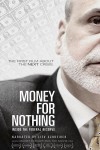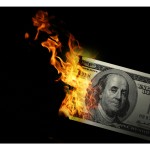submitted by jwithrow.
Tag: central banking
The Middle-Class is Fading
submitted by jwithrow.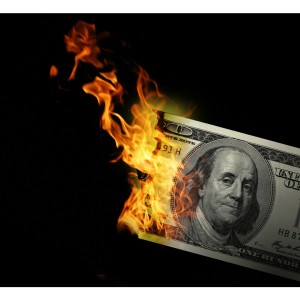
The middle-class is fading. Fast.
The jobs that have been lost since the financial system teetered on implosion in 2008 have not come back. Those jobs are not coming back. More education won’t bring them back. More laws won’t bring them back.
The government’s job report says that more and more jobs are being created, but guess what? They are mostly low paid part-time or temporary jobs; they are not the middle management jobs in the high rise buildings.
As for why the middle-class is being wiped out, it’s no mystery. This very same scenario has occurred all throughout history. One can look back as far as the time of the Roman Empire and see that there is nothing new under the sun. History rhymes and those ignorant of history are doomed to repeat its mistakes.
You see, every time the currency of the land has been inflated and debased, the middle-class has been destroyed. Inflation transfers value from those who must work to earn currency to those who control the currency supply.
They don’t tell you this in school. They don’t tell you this in college. They don’t even tell you this if you major in finance or economics. They probably don’t know themselves. So most people never understand what is happening. Their paycheck gets bigger and bigger so they can’t figure out why they can never get ahead. They don’t realize that their bigger paycheck is buying less and less. They don’t understand the difference between nominal income and real income.
In Roman times it was the government that controlled the currency supply. The Romans would collect taxes and tributes from citizens and conquered peoples and they would then melt the precious metal coins and add in cheaper metals such as copper to re-mint more coins of lower value. They would then pay the Roman army with these cheaper coins and pretend that they had the same value as before. The general market caught on to this process and began to charge higher prices for food and goods in response. The middle-class was destroyed over time and eventually the economy collapsed. Then the Empire fell.
In modern times it is the Federal Reserve and the other central banks of the world that control the currency supply. They do this by simply creating currency units from nothing and using the new currency as they see fit. They inject some of this new currency into the banking system, they use some of the new currency to buy government debt, and they inject some of the new currency into the IMF and foreign central banks. This directly leads to more and more debt and an increase in consumer prices across the board.
They are printing currency at will so why is the middle-class working so hard for 2% annual raises?
The rules of the game have changed and those unable to recognize this and adjust accordingly will be wiped out with the middle-class – just as has happened throughout history.
What We Forgot About Free Market Capitalism Part Two
submitted by jwithrow.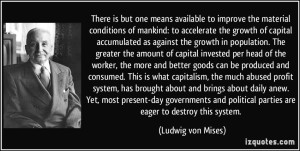
Failure is just as much a facet of free market capitalism as success is.
In a free market economy, well managed businesses with desired products and services will succeed and poorly managed business with undesired products and services will fail.
Consumers, when well informed, will make decisions based on their individual preferences; they will either buy the highest quality product at the lowest price for which that product is available or they will buy a lower quality product for a price lower than the higher quality product. Consumers are typically not very interested in paying high quality prices for low quality products.
So, in the free market, businesses must constantly strive to either offer the best product at the lowest price or a suitable product at a very low price. This requires businesses to focus on improving efficiency and decreasing costs without sacrificing product quality. If a business cannot offer competitive products at competitive prices then it will not be in business for very long.
This model aligns the interests of both businesses and consumers and creates a self-regulating incentive structure.
In the free market system, businesses have an incentive to offer quality products to customers at the best price and they have a disincentive to offer poor products at poor prices. While this is a simple representation, the incentive structure is one of the core principals underlying the free market system.
But what happens if businesses are not allowed to fail due to government intervention?
We have seen numerous cases of this scenario in recent years. The “too big to fail” banks were propped up by the federal government when they came to the point of failure. Fannie Mae and Freddie Mac were taken under receivership by the federal government when they came to the point of failure. General Motors was temporarily taken over and propped up by the federal government when it came to the point of failure.
This is moral hazard.
Oh, and we should probably mention that the federal government cannot actually bail anything out with its own capital. To fund the bail-outs, the government has to appropriate capital from the private sector in the form of tax dollars and it has to borrow money from the Federal Reserve that was created out of thin air.
So the business losses were socialized but the profits remained privatized – this is fascism in action.
By creating moral hazard in this way, the disincentive piece has been removed from the system and the incentive model has shifted away from a consumer focus and to a focus on generating high profits with no regard for risk. Such a model is a win-win for the favored businesses and the government cronies that they support. The losers are everyone else as the economy turns to mush.
Coming full circle, failure is a welcome facet of free market capitalism. Maybe not for the companies’ doing the failing, but failure is a force for creative destruction that serves to weed out the businesses that cannot offer quality products at reasonable prices.
This is why it is ridiculous to claim that any company is “too big to fail” as justification for bail-outs. Sure there would be temporary hardship were the major banks to fail, but this would eventually free up capital and clear the way for sustainable banking practices to be implemented.
What We Forgot About Free Market Capitalism Part 1
submitted by jwithrow.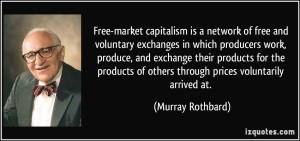
One of the most important elements of free market capitalism is the price system. The capitalist price system provides information on supply and demand in the marketplace and individuals make business and investment decisions based on this information.
The economic system that America now employs is not free market capitalism and there are legions of regulations in place that distort the market pricing system every step of the way.
The most insidious price distortion is the suppression of interest rates.
Interest rates are simply the price of money. Like everything else in the market economy, interest rates are self-regulated by the forces of supply and demand. If there is a high quantity of capital in the system available for lending then interest rates will naturally be low. Low interest rates will entice borrowers to engage in long term financing – purchasing homes, expanding businesses, etc. Interest rates will then naturally rise as the capital available for lending diminishes. High interest rates are not attractive to borrowers so individuals and businesses will focus more on short term projects. This will lead to increased capital formation within the system which will gradually trigger falling interest rates.
But what happens when a central bank suppresses interest rates and keeps them near zero for an extended period of time? Well, this destroys the entire pricing system and distorts the entire market system.
Artificially suppressed interest rates send a false signal – which is exactly why they were suppressed in the first place. Artificially suppressed rates still entice borrowers to take engage in long term financing but this is a Keynesian trap. The problem is that there is not sufficient capital formation in the economy to warrant the low interest rates and thus there is not a true demand for all of the long term projects undertaken.
This is called mal-investment.
“If you build it, they will come” is a great catch phrase in the movies but it’s just not how the real world works.
Despite what the economics textbook says, there is no such thing as a ‘mixed economic system’. There is simply no room for the suppression of interest rates or the distortion of prices in a capitalist system.
There are only two choices:
- Free markets
- Central planning
Free market capitalism presumes an honest and functional price system that is not manipulated by a central bank.
Oh, we should probably mention how interest rates are suppressed.
The Federal Reserve creates currency units out of thin air and uses them to buy long term Treasury bonds at low rates. What could possibly go wrong?
By the way, you can read more on this topic here, here, and here.
